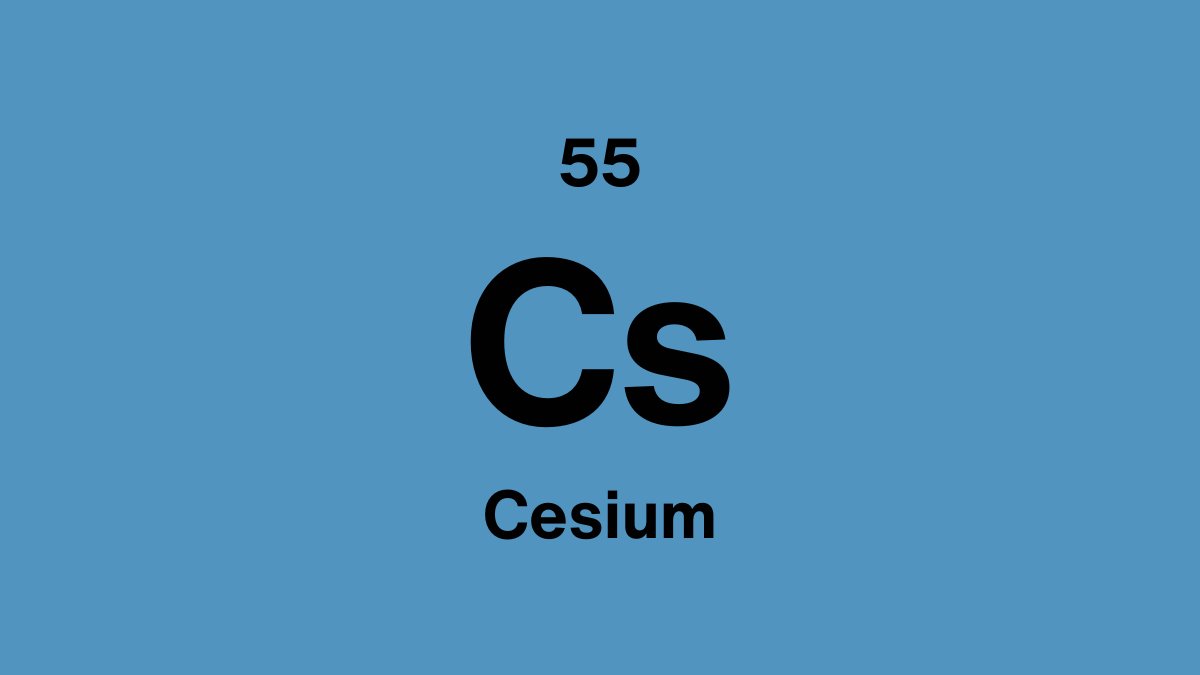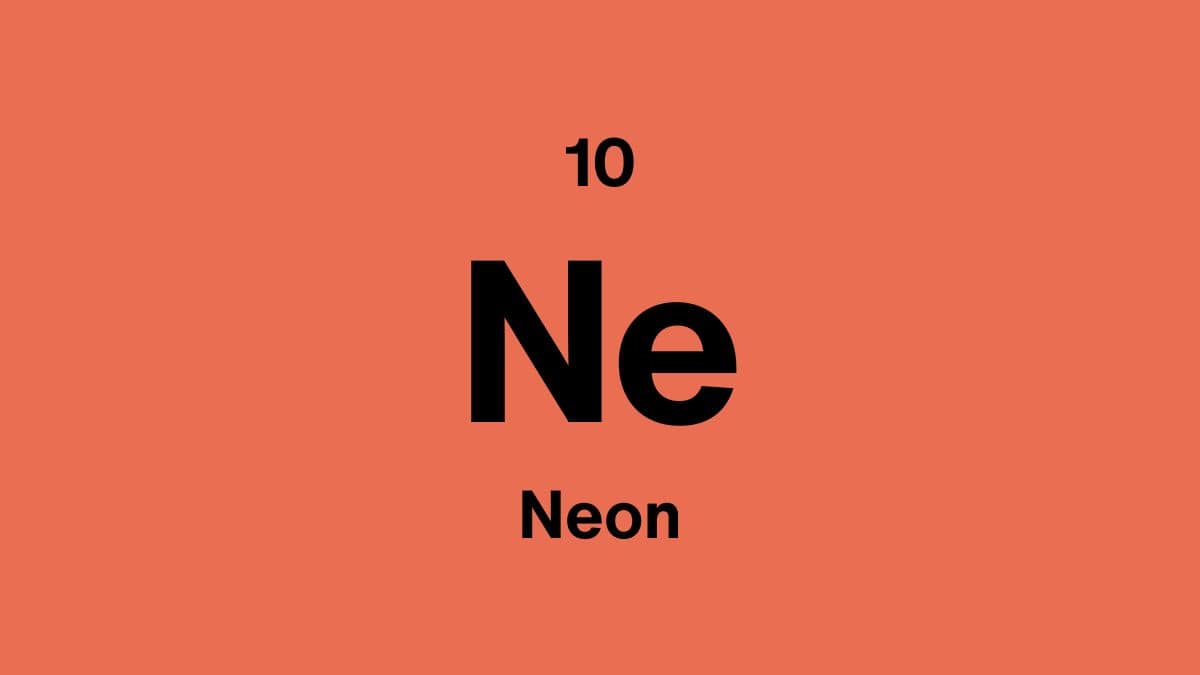The explosive metal that keeps GPS working and defines what a second actually means
Alkali metals occupy Group 1 of the periodic table and are among the most reactive elements known to chemistry. These silvery metals have a single electron in their outermost shell, which they readily lose to form positive ions with a +1 charge. This single valence electron makes alkali metals extremely electropositive and eager to react with other elements. They are soft enough to be cut with a knife, have low melting points compared to other metals, and must be stored under oil or in inert atmospheres to prevent reaction with air and moisture. As you move down Group 1 from lithium to cesium, reactivity increases dramatically while density, melting point, and hardness decrease.
In this article, we explore cesium's properties, its spectroscopic discovery that launched a new era in chemistry, revolutionary applications in timekeeping and navigation, critical role in oil extraction, and the extreme precautions required when handling Earth's most reactive metal.
Properties of cesium
| Atomic Number: | 55 |
| Atomic Symbol: | Cs |
| Atomic Weight (amu): | 132.905 |
| Electronegativity: | 0.79 |
| Melting point: | 28.44°C | 83.19°F | 301.59K |
| Boiling point: | 671.00°C | 1239.80°F | 944.15K |
What does cesium look like?
Cesium is a soft, silvery-white metal with a distinctive golden cast that gives it a pale gold appearance. The metal is so soft it can be cut with a knife or even squeezed in your hand like wax. Cesium has a characteristic metallic luster when freshly cut, but it tarnishes rapidly when exposed to air, forming a dull coating as it reacts with oxygen. When heated or excited by electricity, cesium produces a distinctive spectrum containing two prominent bright blue lines along with several spectral lines in the red, yellow, and green wavelengths. This unique blue emission is responsible for its name, derived from the Latin word caesius meaning sky-blue or heavenly blue.
Will we ever run out of cesium?
Cesium is present in Earth's crust at approximately 3 parts per million, making it about half as abundant as lead and roughly 70 times more abundant than silver. While not extremely rare, cesium is concentrated in only a few economically viable deposits worldwide. The world's largest and richest source is the Bernic Lake deposit in Manitoba, Canada, which contains an estimated 300,000 tons of pollucite ore averaging 20 percent cesium and accounts for more than two-thirds of global reserves.
Other significant deposits exist in Namibia and Zimbabwe, and cesium occurs in brines in Chile and China, though these have not been commercially exploited. Despite limited sources, current consumption is modest because only small quantities are needed for most applications. With careful management and recycling of cesium formate drilling fluids, supplies should remain adequate for foreseeable demand.
Can cesium be recycled
Yes, cesium can be recycled effectively, and recycling is economically important given cesium's cost and limited natural sources. Approximately 85 percent of cesium formate used in oil drilling operations can be retrieved and recycled for subsequent drilling projects.
Recycled cesium is commonly sourced from:
- Cesium formate drilling fluids recovered from oil and gas operations
- Decommissioned atomic clocks and precision timing devices
- Photoelectric cells and photomultiplier tubes after service life
- Industrial vacuum tubes and getters from electronics manufacturing
Where can cesium be found?
Cesium does not occur in pure elemental form in nature due to its extreme reactivity with air and water. Instead, it exists in various minerals combined with other elements, typically found in lithium-bearing granite pegmatites.
- Pollucite: The primary ore of cesium, a cesium aluminum silicate mineral with the formula Cs4Al4Si9O26·H2O. Pure pollucite contains 40.1 percent cesium, though commercial deposits typically contain 20 to 25 percent after hand-sorting impurities.
- Lepidolite: A lithium-rich mica mineral that contains minor amounts of cesium, though not concentrated enough for primary cesium extraction.
- Beryl: A beryllium aluminum silicate that can contain trace amounts of cesium.
- Feldspar: Common rock-forming minerals that may contain small quantities of cesium.
- Mineral Spring Waters: Cesium was first detected in mineral spring waters in Germany, where Bunsen and Kirchhoff discovered the element in 1860.
Cesium is produced primarily in Canada, which dominates global production through the Bernic Lake deposit owned by Cabot Corporation. This single deposit controls approximately 82 percent of the world's reported pollucite reserves. Small-scale production also occurs in Namibia, and cesium can be extracted from pollucite deposits in China and Italy. Although cesium occurrences exist in the United States, including pegmatite deposits, no domestic mining occurs, and all cesium is imported. World production is estimated at more than 45,000 kilograms annually.
Is cesium expensive?
Yes, cesium is relatively expensive due to its limited sources and specialized extraction requirements. Pure cesium metal typically costs between 38 and 40 dollars per gram, making it one of the more expensive metallic elements. However, because applications require only minute quantities, the total cost for most uses remains manageable. For example, atomic clocks use extremely small amounts of cesium, and even oil drilling operations can recycle most of the cesium formate fluid, reducing overall consumption.
Does cesium have a biological role?
Cesium has no known essential biological role in humans or other living organisms. Non-radioactive cesium compounds are only mildly toxic, and the body treats cesium ions similarly to potassium ions because of their similar chemical properties. This similarity allows cesium to be absorbed and distributed throughout the body if ingested. While low-level exposure to stable cesium is not particularly harmful, accidental ingestion can affect the liver, intestines, and kidneys.
The radioactive isotope cesium-137, with a half-life of approximately 30 years, poses serious health and environmental hazards. This isotope is produced by nuclear fission of uranium-235 and was released in significant quantities during the Chernobyl and Fukushima nuclear disasters. Cesium-137 accumulates in soft tissues and muscle, delivering prolonged radiation exposure that increases cancer risk. However, controlled medical applications of cesium-131 and cesium-137 are used in brachytherapy to treat prostate cancer and breast cancer by implanting radioactive seeds near tumor sites to destroy cancerous cells.
What is pure cesium used for?
- Atomic Clocks: Cesium atomic clocks define the international standard for measuring time. Since 1967, the second has been officially defined as exactly 9,192,631,770 oscillations of the cesium-133 atom. These clocks are accurate to within one second every 50 million years and are essential for GPS satellites, internet synchronization, cell phone networks, and aircraft navigation systems.
- Oil Drilling Fluids: Since the 1990s, cesium formate brines have become the largest application of cesium, consuming more than half of annual production. These high-density, low-viscosity fluids maintain hydrostatic pressure in high-temperature, high-pressure oil and gas wells, protect drilling equipment from thermal degradation, and cool drill bits during operation.
- Photoelectric Devices: Cesium readily emits electrons when struck by light, making it valuable in photoelectric cells, photomultiplier tubes, scintillation counters, and infrared spectrophotometers. Cesium-based cathodes have exceptionally low threshold voltages for electron emission.
- Getter Material: Cesium's affinity for oxygen makes it useful as a getter in vacuum tubes, where it removes trace gases and oxygen trapped during tube sealing, ensuring proper vacuum conditions.
- Medical Radiotherapy: Cesium-131 treats prostate cancer through brachytherapy with shorter half-life and higher energy than alternatives like iodine-125. Cesium-137 has been used experimentally for breast cancer radiation therapy.
- Ion Propulsion: Cesium ions, with their high atomic mass and ease of ionization, are being developed for plasma propulsion engines that could provide extraordinarily high exhaust velocities for deep-space exploration.
- Catalysts: Cesium compounds enhance the effectiveness of various industrial catalysts used in producing acrylic acid, ethylene oxide, methanol, styrene, and other chemicals.
- Scintillation Detectors: Cesium iodide, cesium bromide, and cesium fluoride crystals detect gamma rays and X-rays in mineral exploration and particle physics research.
What are the main compounds with cesium?
- Cesium Formate (HCOOCs) : The most commercially important cesium compound, used in drilling fluids for high-pressure, high-temperature oil and gas operations. Its high density and low viscosity make it ideal for maintaining well pressure while being environmentally benign and recyclable.
- Cesium Chloride (CsCl) : Used in molecular biology for density gradient ultracentrifugation to isolate viral particles, organelles, and nucleic acids. It crystallizes in the simple cubic crystal structure, which is named after it.
- Cesium Hydroxide (CsOH) : The strongest base known to chemistry, capable of attacking glass. Used in desulfurizing heavy crude oil and in specialized chemical synthesis requiring extremely strong bases.
- Cesium Fluoride (CsF) : A hygroscopic white solid widely used in organofluorine chemistry as a source of fluoride anions. Cesium and fluorine have the lowest and highest electronegativities respectively among all elements.
- Cesium Iodide (CsI) : Used in scintillation detectors for gamma and X-ray radiation detection. Its high density and atomic number provide excellent stopping power for radiation.
- Cesium Nitrate (CsNO3) : One of cesium's most common compounds, primarily used to produce other cesium chemicals and in pyrotechnics to produce blue-violet colors.
- Cesium Azide (CsN3) : Thermally decomposes to produce extremely pure, gas-free cesium metal needed for vacuum tube getters and precision applications.
Who discovered cesium?
Cesium was discovered in 1860 by German chemists Robert Bunsen and Gustav Kirchhoff at the University of Heidelberg, making it the first element ever discovered by spectroscopy. This discovery represented a revolutionary moment in chemistry because it demonstrated that spectroscopic analysis could identify new elements by their characteristic light emissions, even when present in minute quantities impossible to detect by conventional chemical methods.
Bunsen and Kirchhoff were analyzing mineral water from the springs at Durkheim, Germany, using their newly invented spectroscope, a device that separated light into its component colors to reveal characteristic spectral lines unique to each element. When they examined the mineral water, they observed two brilliant blue spectral lines that had never been seen before and could not be attributed to any known element. These distinctive blue lines convinced them they had discovered a new element, which they named cesium from the Latin word caesius, meaning sky-blue or heavenly blue, in honor of the bright blue spectral lines.
Bunsen was able to isolate cesium chloride from the mineral water by evaporating large quantities and crystallizing the mixed alkali salts. He prepared several other cesium salts including the carbonate and tartrate. However, it was not until 1881 that Swedish chemist Carl Setterberg at the University of Bonn successfully isolated pure metallic cesium by electrolysis of molten cesium cyanide, allowing scientists to study the element's physical properties for the first time. The discovery of cesium validated spectroscopy as a powerful analytical tool and opened a new chapter in element discovery that would continue with rubidium, thallium, indium, and many others.
Is cesium dangerous?
Yes, cesium metal is extremely dangerous and classified as a hazardous material due to its explosive reactivity with water and air. Cesium reacts violently and explosively even with ice at temperatures as low as -116 degrees Celsius. When cesium contacts water, it produces hydrogen gas and heat so rapidly that the hydrogen ignites and explodes, while simultaneously forming cesium hydroxide, the strongest base known to chemistry. This base is corrosive enough to attack and dissolve glass.
Pure cesium metal ignites spontaneously when exposed to air and must be stored under mineral oil or sealed in inert atmospheres of argon or nitrogen. Despite having a melting point just above room temperature at 28.4 degrees Celsius, making it tempting to hold, cesium would cause severe chemical burns and potentially explosive reactions with moisture on skin. Workers handling cesium must use extreme caution, specialized containment, protective equipment, and dry, oxygen-free conditions.
While non-radioactive cesium compounds are only mildly toxic and the element itself is not particularly poisonous in small amounts, the radioactive isotope cesium-137 presents severe health and environmental hazards. This isotope, produced by nuclear fission, has a 30-year half-life and emits dangerous gamma radiation. Major releases occurred during the Chernobyl and Fukushima nuclear disasters. Cesium-137 accumulates in soft tissues and muscle, where it delivers prolonged radiation exposure increasing cancer risk. Proper handling, storage, and disposal of radioactive cesium requires strict adherence to radiation safety protocols.
Fun facts about cesium
- Cesium is one of only five metallic elements that are liquid at or near room temperature. The others are mercury, gallium, rubidium, and francium. With a melting point of just 28.4 degrees Celsius, cesium will melt if held in a closed hand, though this would be extremely dangerous.
- Cesium is the most electropositive element on the periodic table with an electronegativity of 0.79 on the Pauling scale. This means it loses its outermost electron more readily than any other element, making it the most reactive metal and the most alkaline element known.
- The international definition of a second, established in 1967, is based on cesium-133 atoms. One second is defined as exactly 9,192,631,770 periods of the radiation corresponding to the transition between two specific energy levels of the ground state of the cesium-133 atom. This makes cesium the basis for all modern timekeeping.
- Cesium has more isotopes than any other element, with 32 known isotopes having masses ranging from 114 to 145 atomic mass units. However, only cesium-133 is stable, while all others are radioactive with various half-lives.
- Cesium and rubidium are completely miscible in all proportions with complete solid solubility. Their alloy reaches a melting-point minimum of just 9 degrees Celsius, creating one of the lowest-melting metallic mixtures known.
- GPS satellites depend on cesium atomic clocks to maintain the precision timing required for accurate positioning. Each GPS satellite contains multiple cesium and rubidium atomic clocks. Since position is calculated from signal timing, even microsecond errors would result in positioning errors of hundreds of meters.
- In 1846, German chemist Carl Plattner analyzed only 93 percent of the mineral pollucite and concluded it contained only sodium and potassium. The missing 7 percent was actually cesium, which remained undiscovered for another 14 years until Bunsen and Kirchhoff identified it spectroscopically.
- Cesium under extreme pressures exceeding 30 gigapascals can form unusual compounds where cesium exhibits oxidation states from +2 to +6, completely contrary to its normal +1 state. Under these conditions, theoretical studies suggest inner electrons can participate in bonding, making cesium behave as if it were a p-block element.
Scientific data verified from RSC, Britannica, and the Minerals Education Coalition.



